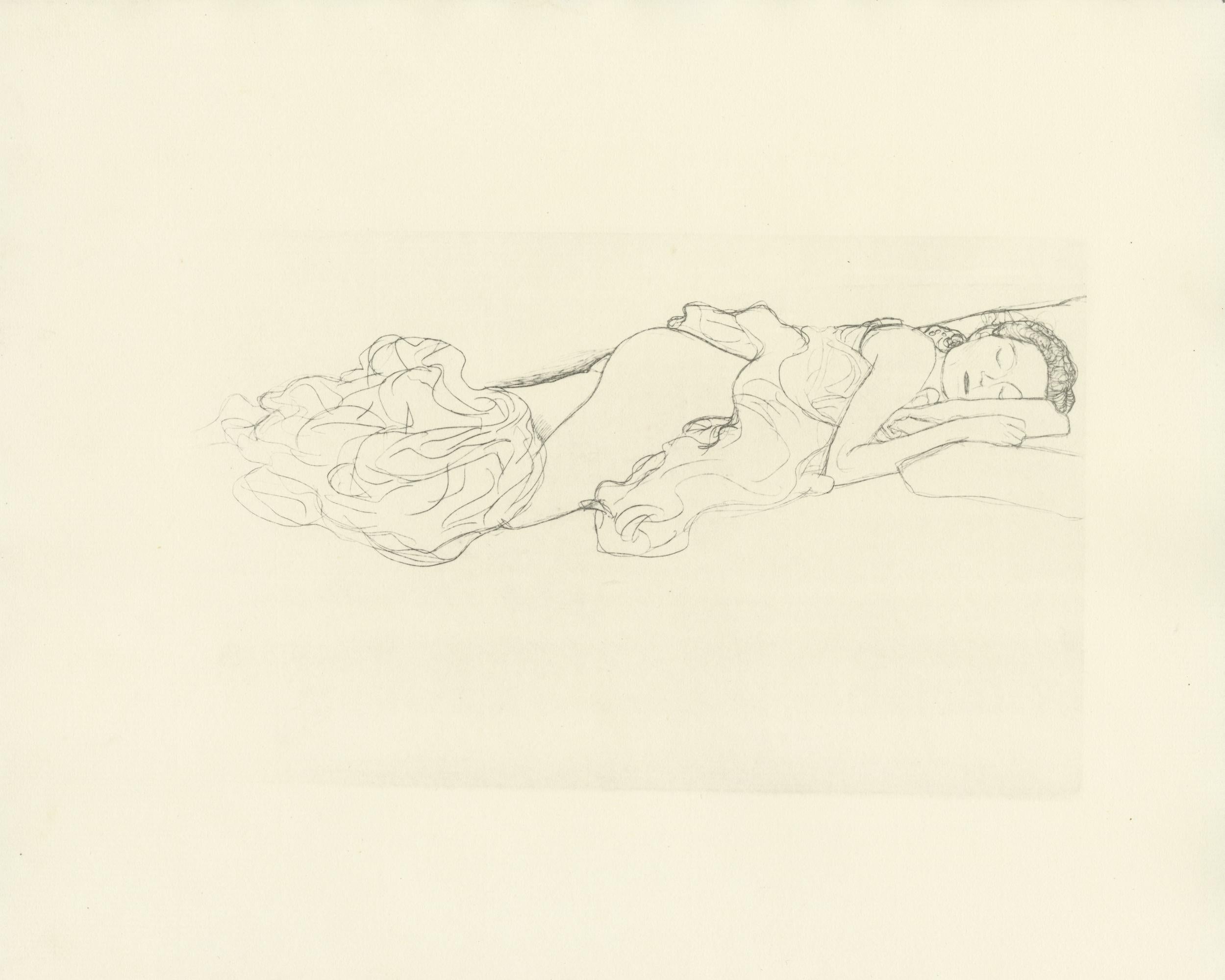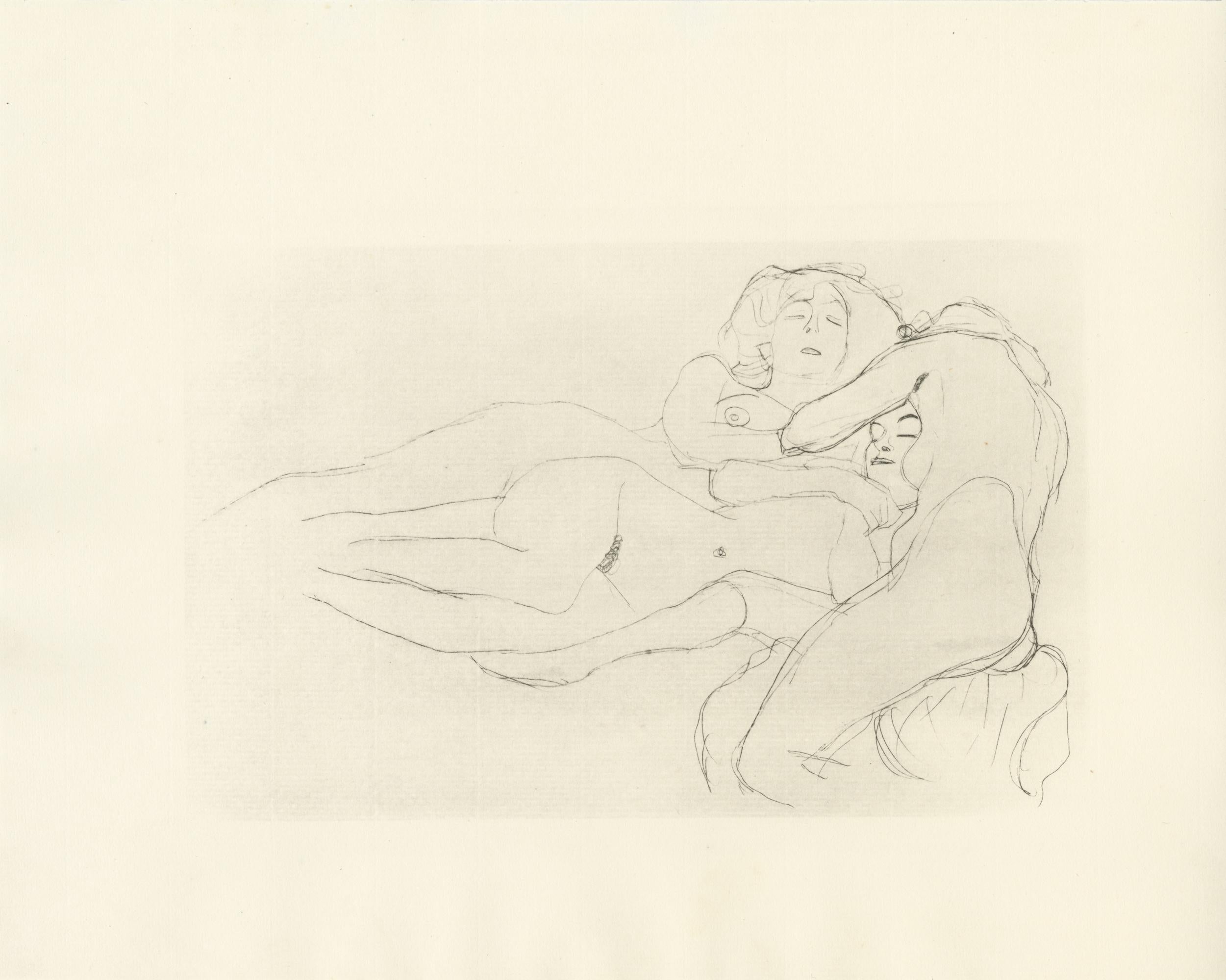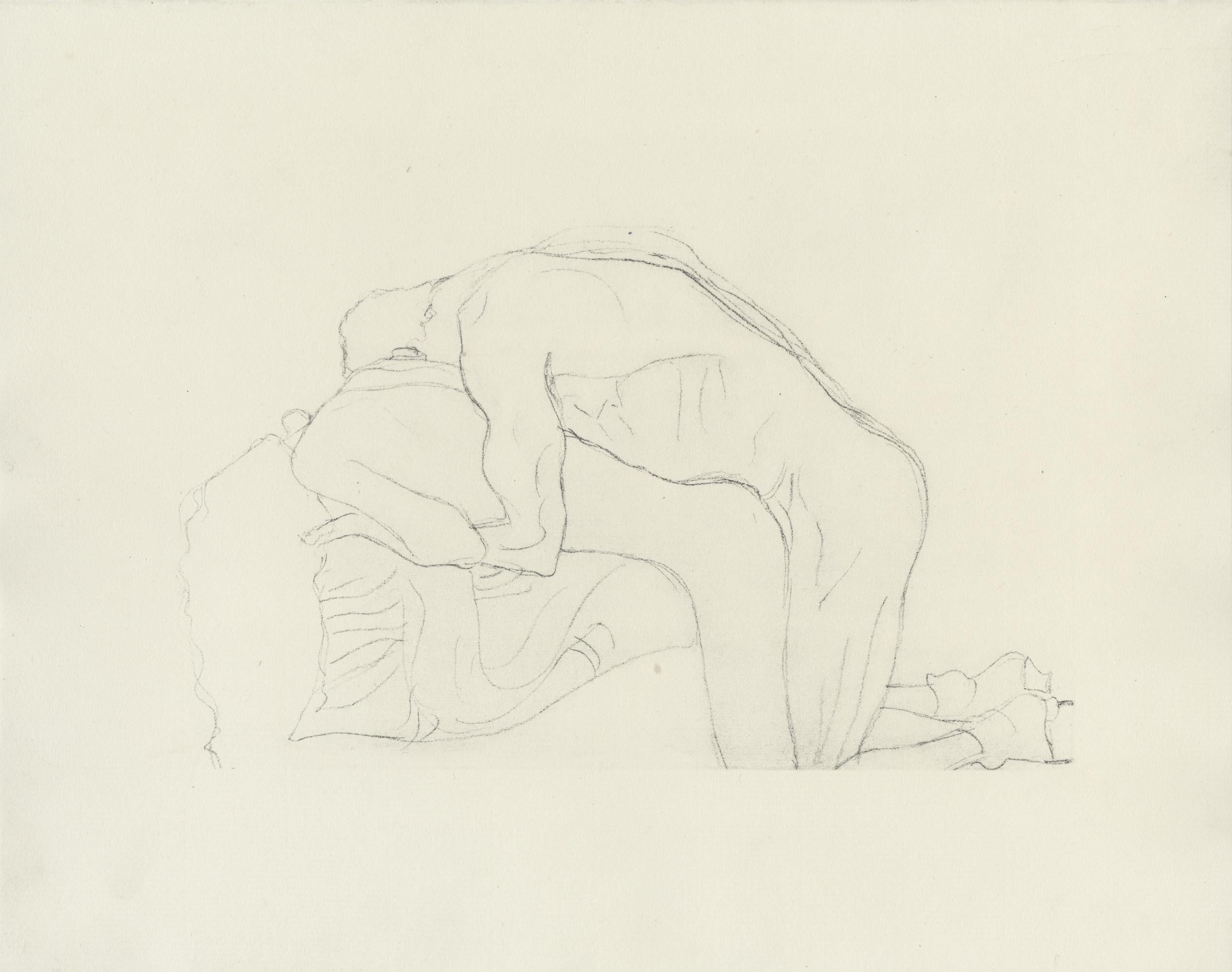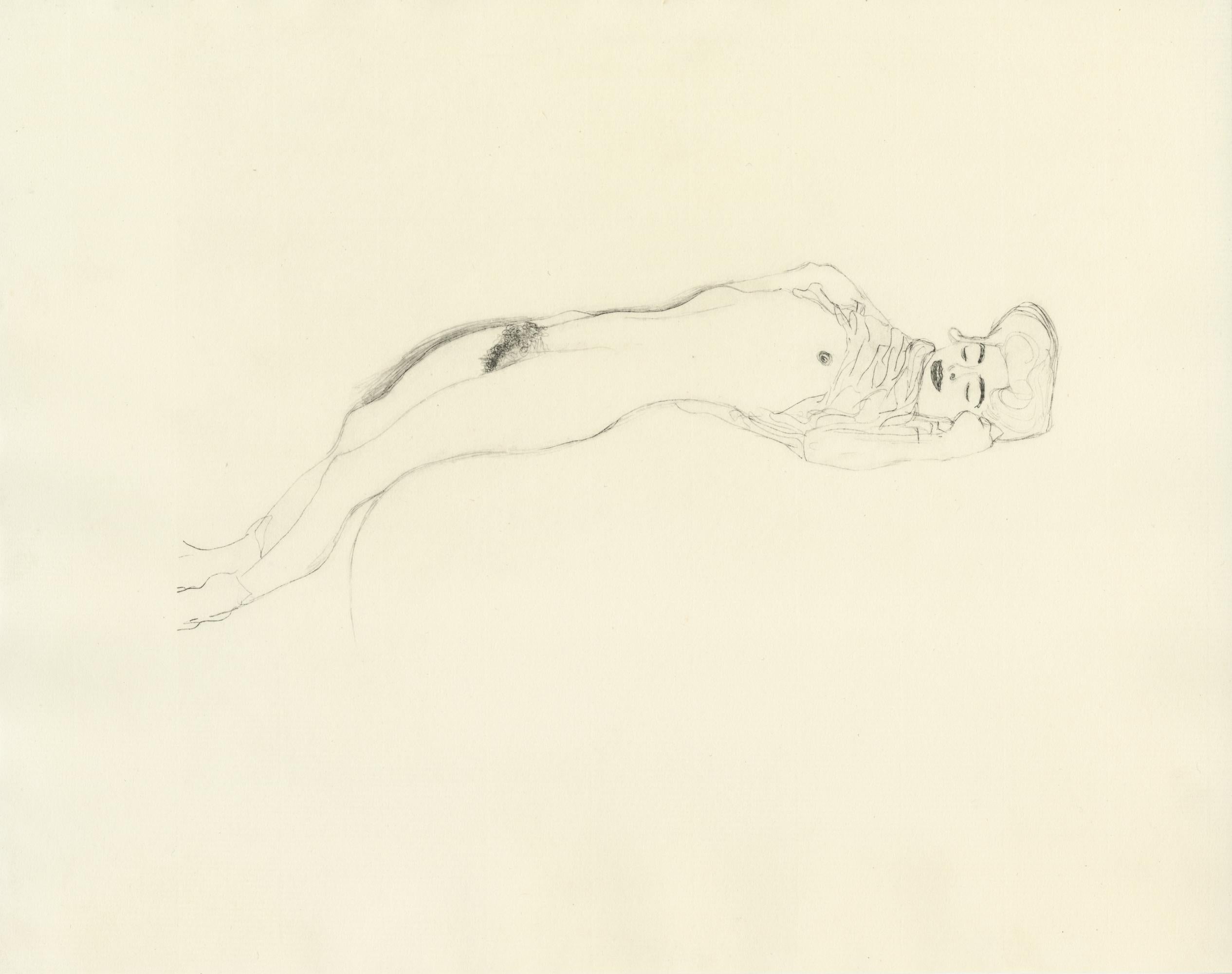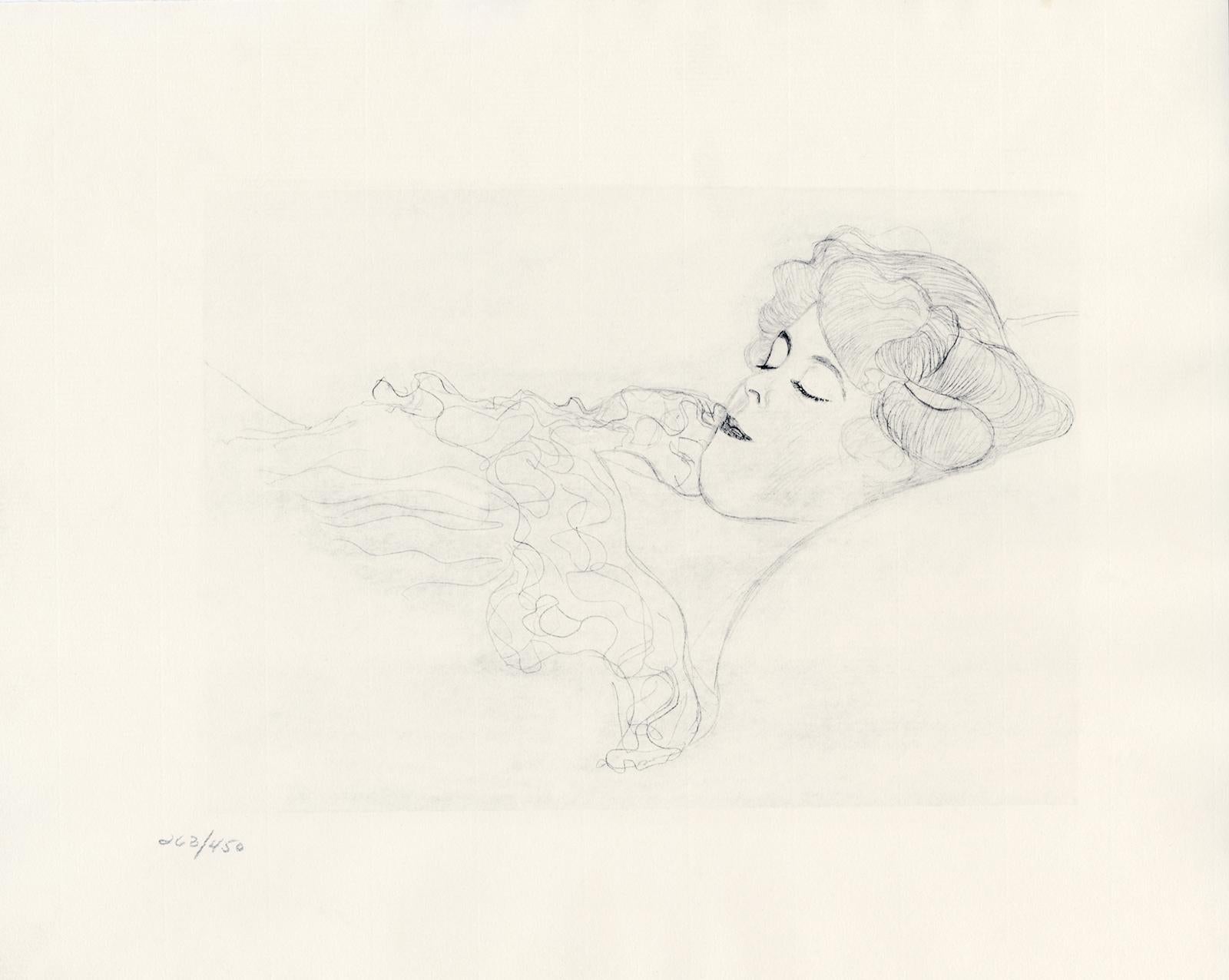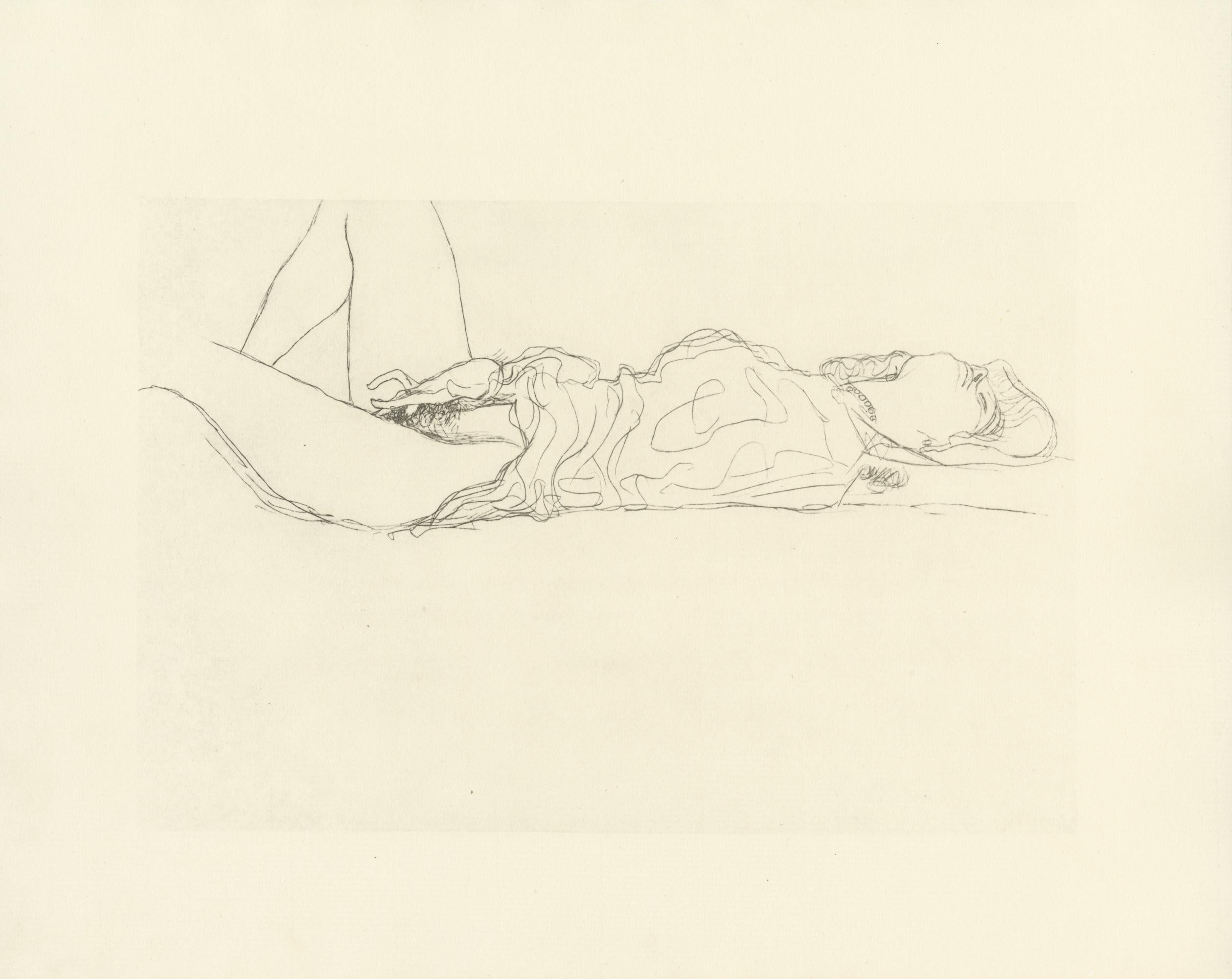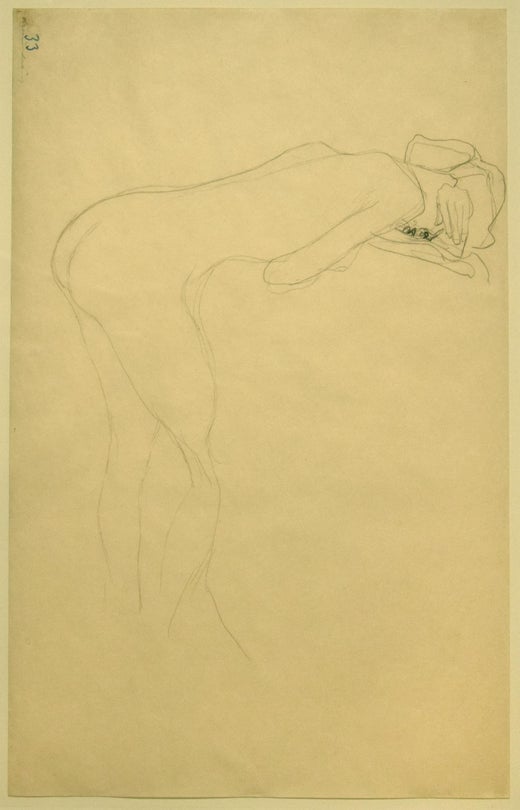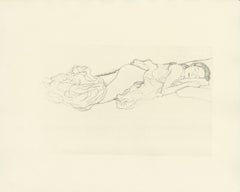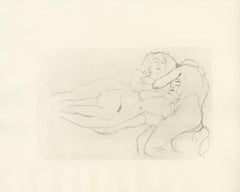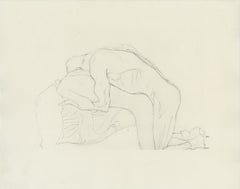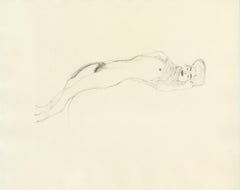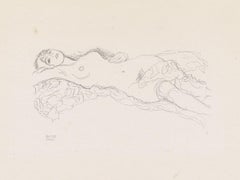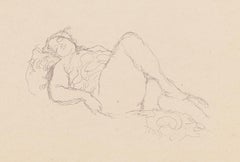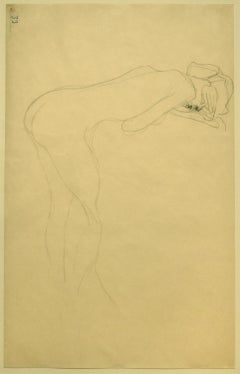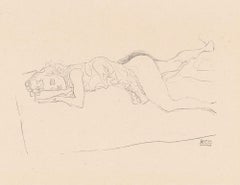Items Similar to "Sleeping Couple" by Gustav Klimt - Original Print from Courtesans Folio
Want more images or videos?
Request additional images or videos from the seller
1 of 6
Gustav Klimt"Sleeping Couple" by Gustav Klimt - Original Print from Courtesans Folio1907
1907
$3,400
£2,629.76
€2,993.83
CA$4,881.85
A$5,333.57
CHF 2,795.34
MX$63,684.56
NOK 35,375.34
SEK 32,986.77
DKK 22,359.13
About the Item
Plate #15 from Gustav Klimt's 1907 "Dialogues of the Courtesans" portfolio, consisting of 15 collotypes on cream japon paper. The drawings in this folio are said to be studies for Klimt's well-known Water Serpents paintings.
This print is from folio 263/450.
Publisher: Julius Zeitler, Leipzig.
Printer: W. Drugulin, Leipzig.
From the Toledo Museum of Art:
When not creating paintings for exhibitions and commissions, Gustav Klimt produced over 4,000 personal drawings and sketches. His drawings were frequently highly erotic—even graphic and sexually taboo—in nature. In them Klimt often rejected the decorativeness and detail of his paintings, working instead in a looser and more minimal style. The 15 drawings presented in this publication of Lucian’s Dialogue of Greek Courtesans, chosen by translator and publisher Franz Blei (who, as a writer, was known for eroticism in his work as well), are virtually unrelated to the text, as the dialogue discusses the role of courtesans (i.e. prostitutes) in society. Klimt’s drawings instead portray female eroticism in varying degrees of explicitness, a subject that would bring him notoriety and complaints of obscenity.
- Creator:Gustav Klimt (1862 - 1918, Austrian)
- Creation Year:1907
- Dimensions:Height: 11 in (27.94 cm)Width: 13.75 in (34.93 cm)
- Medium:
- Movement & Style:
- Period:
- Condition:
- Gallery Location:Palm Beach, FL
- Reference Number:1stDibs: LU467314424842
Gustav Klimt
Gustav Klimt was an Austrian symbolist painter and a prominent member of the Vienna Secession movement. Klimt's primary subject was the female body and his works are mostly erotic in nature.
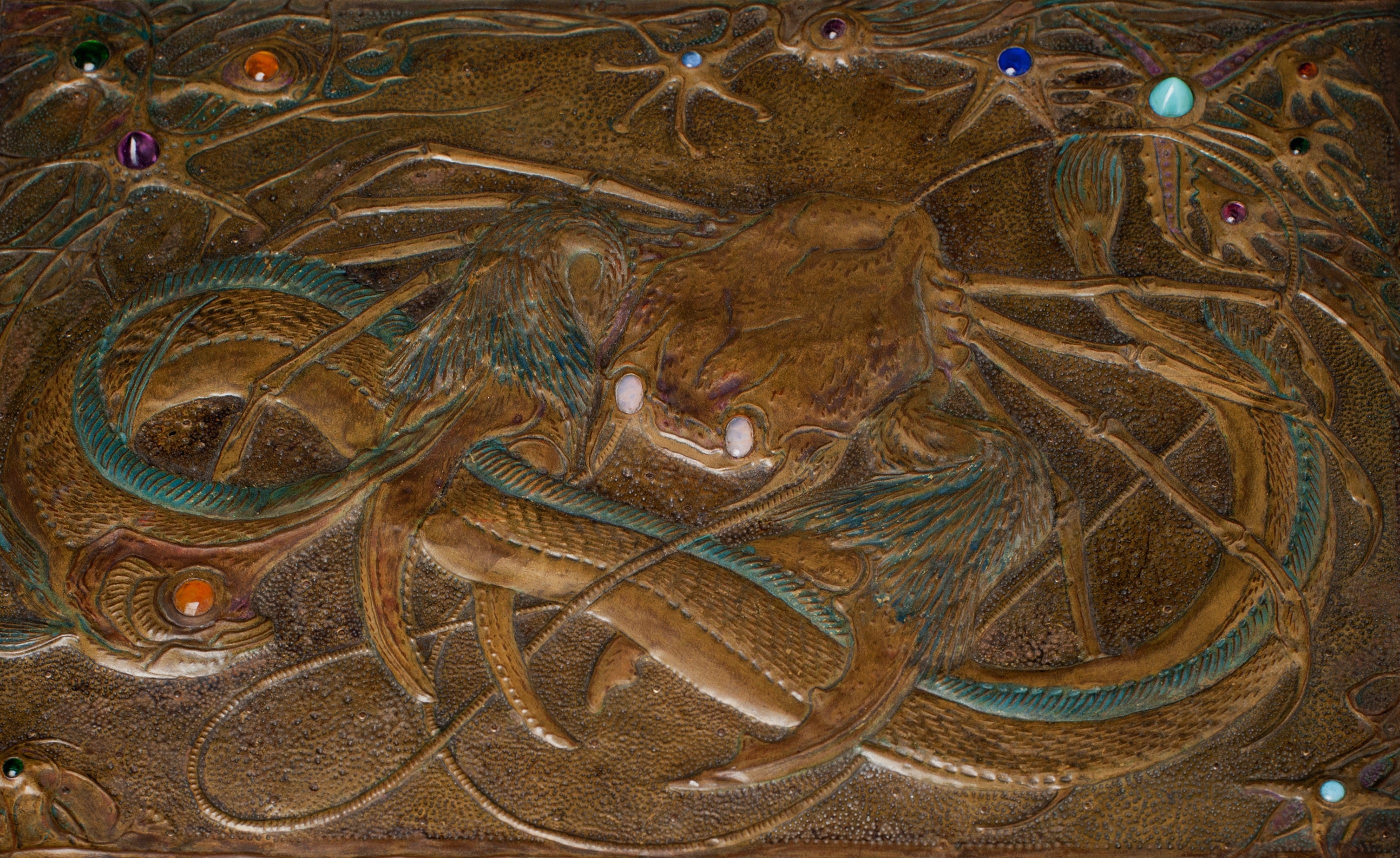
About the Seller
5.0
Vetted Professional Seller
Every seller passes strict standards for authenticity and reliability
Established in 2013
1stDibs seller since 2016
102 sales on 1stDibs
Typical response time: 7 hours
- ShippingRetrieving quote...Shipping from: Palm Beach, FL
- Return Policy
More From This Seller
View All"Women Sleeping Face Down" by Gustav Klimt - Original Print from Courtesan Folio
By Gustav Klimt
Located in Palm Beach, FL
Plate #12 from Gustav Klimt's 1907 "Dialogues of the Courtesans" portfolio, consisting of 15 collotypes on cream japon paper. The drawings in this folio are said to be studies for Klimt's well-known Water Serpents paintings...
Category
Early 1900s Vienna Secession Figurative Prints
Materials
Paper
"Three Women Asleep" by Gustav Klimt - Original Print from Courtesans Folio
By Gustav Klimt
Located in Palm Beach, FL
Plate #13 from Gustav Klimt's 1907 "Dialogues of the Courtesans" portfolio, consisting of 15 collotypes on cream japon paper. The drawings in this folio are said to be studies for Klimt's well-known Water Serpents paintings...
Category
Early 1900s Vienna Secession Figurative Prints
Materials
Paper
"Couple Making Love" by Gustav Klimt - Original Print from Courtesans Folio
By Gustav Klimt
Located in Palm Beach, FL
Plate #4 from Gustav Klimt's 1907 "Dialogues of the Courtesans" portfolio, consisting of 15 collotypes on cream japon paper. The drawings in this folio are said to be studies for Kli...
Category
Early 1900s Vienna Secession Figurative Prints
Materials
Paper
"Smiling Woman Reclined" by Gustav Klimt - Original Print from Courtesans Folio
By Gustav Klimt
Located in Palm Beach, FL
Plate #14 from Gustav Klimt's 1907 "Dialogues of the Courtesans" portfolio, consisting of 15 collotypes on cream japon paper. The drawings in this folio are said to be studies for Klimt's well-known Water Serpents paintings...
Category
Early 1900s Vienna Secession Figurative Prints
Materials
Paper
"Sleeping Woman" by Gustav Klimt - Original Print from Courtesans Folio
By Gustav Klimt
Located in Palm Beach, FL
Plate #1 from Gustav Klimt's 1907 "Dialogues of the Courtesans" portfolio, consisting of 15 collotypes on cream japon paper. The drawings in this folio are said to be studies for Kli...
Category
Early 1900s Vienna Secession Figurative Prints
Materials
Paper
"Masturbating Woman" by Gustav Klimt - Original Print from Courtesans Folio
By Gustav Klimt
Located in Palm Beach, FL
Plate #9 from Gustav Klimt's 1907 "Dialogues of the Courtesans" portfolio, consisting of 15 collotypes on cream japon paper. The drawings in this folio are said to be studies for Klimt's well-known Water Serpents paintings...
Category
Early 1900s Vienna Secession Figurative Prints
Materials
Paper
You May Also Like
Reclining nude, Gustav Klimt Handzeichnungen (Sketch) collotype lithograph, 1922
By (after) Gustav Klimt
Located in Chicago, IL
Original 1922 collotype lithograph of a reclining nude figure, created from Gustav Kilmt’s handzeichnungen (sketch). Published by Thyrsos Verlag, Leipzig and Vienna, in an edition of 375.
Klimt’s mastery of depth is most evident in the gentleness of his linework. Without the aid of shadow or the subtlety of values, the gestures of line allow the viewer a sense of a three-dimensional person or object. The meticulous lithographic process used to create Klimt’s Handzeichnungen portfolio ensures exceptionally crisp markings bearing a strong resemblance to the original sketches. This series showcases the quintessence behind Klimt’s signature visual style. This artwork arrives accompanied by a certificate of authenticity.
Century Guild has curated collections of Gustav Klimt’s printed...
Category
1920s Vienna Secession Prints and Multiples
Materials
Paper, Lithograph
Reclining nude, Gustav Klimt Handzeichnungen (Sketch), Thyrsos Verlag, 1922
By (after) Gustav Klimt
Located in Chicago, IL
Original collotype lithograph of a reclining nude drawing from Gustav Kilmt’s handzeichnungen (sketch) in 1922 by Thyrsos Verlag, Leipzig and Vienna, in an edition of 375. This artwo...
Category
1920s Vienna Secession Prints and Multiples
Materials
Paper, Lithograph
Nude of Woman Reclined on the Back of a Chair on the Right, Original Drawing
By Gustav Klimt
Located in Roma, IT
Nude of Woman Reclined On the Back of a Chair on the Right is an original drawing realized by Gustav Klimt between 1904 and 1906, probably in 1905, as stated in the Catalogue Raisonn...
Category
Early 1900s Vienna Secession Nude Drawings and Watercolors
Materials
Charcoal
Female semi-nude on bedding, Gustav Klimt Handzeichnungen (Sketch), 1922
By (after) Gustav Klimt
Located in Chicago, IL
Original collotype lithograph of Gustav Kilmt’s Female semi-nude on bedding, published in the 1922 Handzeichnungen portfolio by Thyrsos Verlag, Leipzig and Vienna, in an edition of 375. This artwork is presented in archival rag mat and arrives accompanied by a certificate of authenticity.
Klimt’s mastery of depth is most evident in the gentleness of his linework. Without the aid of shadow or the subtlety of values, the gestures of line allow the viewer a sense of a three-dimensional person or object. The meticulous lithographic process used to create Klimt’s Handzeichnungen portfolio ensures exceptionally crisp markings bearing a strong resemblance to the original sketches. This series showcases the quintessence behind Klimt’s signature visual style. This artwork arrives accompanied by a certificate of authenticity.
Century Guild has curated collections of Gustav Klimt’s printed...
Category
1920s Vienna Secession Prints and Multiples
Materials
Paper, Lithograph
Reclining Nude, Left Leg Raised - Original Lithograph After Egon Schiele
By (after) Egon Schiele
Located in Roma, IT
Reclining Nude, Left Leg Raised is a beautiful and original lithograph from the portfolio "Erotica" by Egon Schiele.
It is a reproduction of the homonym pencil drawing realized by t...
Category
Early 2000s Modern Nude Prints
Materials
Lithograph
Reclining Nude, Left Leg Raised - Original Lithograph after E. Schiele - 2007
By (after) Egon Schiele
Located in Roma, IT
Reclining Nude, Left Leg Raised is a beautiful and original lithograph from the portfolio "Erotica" by Egon Schiele.
It is a reproduction of the homonym pencil drawing realized by t...
Category
Early 2000s Modern Nude Prints
Materials
Lithograph
More Ways To Browse
Serpent Painting
Couple Sleeping
Tadanori Yokoo
Toshusai Sharaku
Utagawa Yoshiiku
Vienna Secession Art Posters
Vincent Gallo
Vintage Coney Island Signs
Vintage Erotism
Vintage Muhammad Ali
Wolfgang Hutter
Woman In The Waves
Wynn Chamberlain
12 Tribes Of Israel
1930s Wpa Prints
1960s Womens Fashion
Alaska Watercolor
Albrecht Durer Woodcut Print
